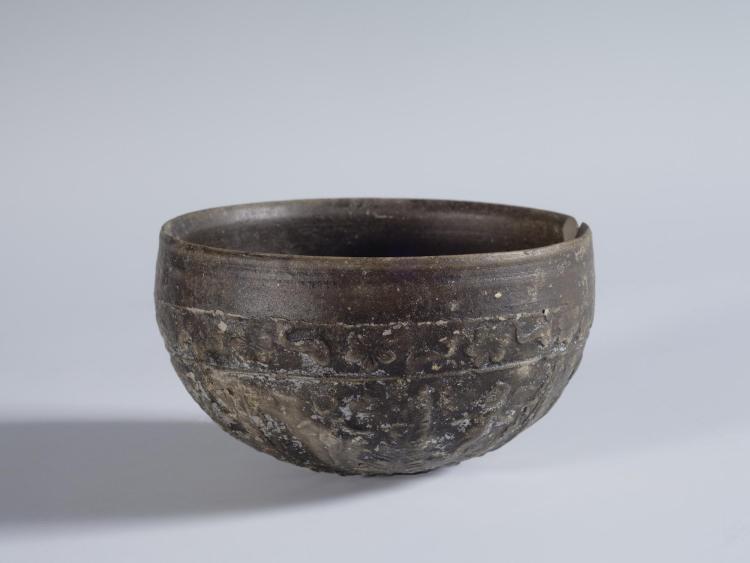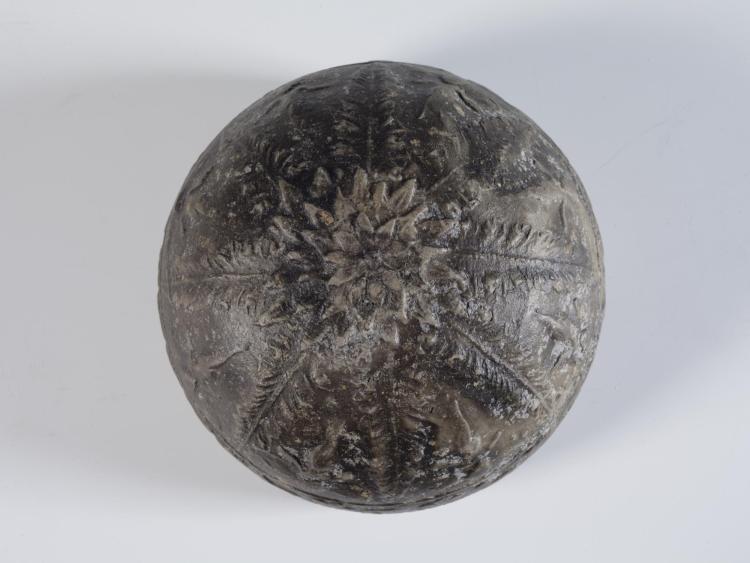2006.14.T, Hellenistic Mould-Made Bowl ("Megarian" Bowl)
Catalogue Entry

This vase is one of a collection of Greek vases held by the CU Art Museum.
Gift to CU Classics Department
Transferred to CU Museum of Natural History
Transferred to CU Art Museum (2006)
Height: 5.7 cm
Diameter (max.): 8.9 cm
Date: c. 150 B.C.E.
Origin: Peloponnese (Greece)
Description: Small round mould-made bowl with floral and figural designs on exterior. Olive green glaze.
Additional photos of this vessel show details of its base, interior, and decoration.
Discussion
This vessel is an example of a so-called Megarian bowl or, more correctly, mould-made relief bowl, a pottery type that appeared in the later 3rd century B.C.E. Unlike earlier, wheelmade wares with surfaces decorated only with slip, paint, and glaze, these bowls were made in stamp-decorated moulds that added decoration in relief. This method of manufacture gave the vessels an embossed effect that may have been intended to imitate metalwork. The vessels were thrown on a potter's wheel while inside the mould in order to produce a smooth and even inner surface while allowing the outside to pick up the pattern of

These bowls functioned as drinking cups and replaced the earlier kantharos shape, a 4th century B.C.E. example of which is included in the CU Art Museum's collection (2). The relief designs were best seen from below, which would be seen when the user drank from the cup.
This particular vessel features a simple design of repeated motifs arranged in rows. The top row consists of small rosettes alternating with dolphins. Below this are representations of dancing Eros figures; Eros was the youngest of the gods and is the Greek equivalent of the Roman Cupid. A floral design covers the bottom of the bowl, with longer acanthus leaves extending up and between the Eros figures above (3). Bowls like this, which feature nearly equal amounts of floral and figural decoration, are classified by Susan Rotroff as "Floral Bowls with Figures" (4). This type was manufactured from the late 3rd to the 2nd century B.C.E. and was contemporary with both vegetal and figural types, including vessels that depict mythological scenes (5). In the 2nd century B.C.E., floral and figural bowls were largely replaced by Long-Petal Bowls, a more stylized type with repeated petal-like motifs covering most of the surface (6).
Comparanda
- Fernand Courby, Les vases grecs à relief (Paris: E. de Boccard, 1922): 388.
- Homer A. Thompson, "Two Centuries of Hellenistic Pottery," Hesperia Vol. 3, No. 4 (1934): 311-476.
- Sylvia Benton, "Excavations in Ithaca, III; The Cave at Polis, II," The Annual of hte British School at Athens Vol. 31 (1938/1939): 33, pl. 16.
- P. V. C. Baur, "Megarian Bowls in the Rebecca Darlington Stoddard Collection of Greek and Italian Vases in Yale University," American Journal of Archaeology Vol. 45, No. 2 (Apr.-Jun., 1941): 229-248, pls. XI-XIII.
- Erika Kunze-Götte, Corpus Vasorum Antiquorum: Deutschland 26, Stuttgart i (Munich: C.H. Beck'sche Verlagsbuchhandlung, 1965): p. 39, 5-6.
- ADelt . 18 (1963): Chronika, Pl, 212 a.
- ADelt . 20 (1965): Chronika, Pl. 480 d.
Footnotes
- On dating and origin of Hellenistic relief bowls, see Susan I. Rotroff, Hellenistic Pottery: Athenian and Imported Moldmade Bowls, The Athenian Agora Vol. XXII (Princeton, NJ: The American School of Classical Studies at Athens, 1982): 6-13; on technique of manufacture, see Rotroff, Hellenistic Pottery: Athenian and Imported Moldmade Bowls: 4-5 . On Hellenistic relief bowls in general, see also J.J. Pollitt, Art in the Hellenistic Age (Cambridge: Cambridge University Press, 1986): 256; John G. Pedley Greek Art and Archaeology (Upper Saddle River, NJ: Prentice Hall, 1993); William R. Biers, The Archaeology of Greece: An Introduction (Ithaca: Cornell University Press, 1980): 314-5; J.W. Hayes "Fine Wares in the Hellenistic World" in eds. Tom Rasmussen and Nigel Spivey, Looking at Greek Vases (Cambridge: Cambridge University Press, 1991): 183-202.
- Rotroff, Hellenistic Pottery: Athenian and Imported Moldmade Bowls:1; Hayes, "Fine Wares in the Hellenistic World": 189.
- Chara Tzavella-Evjen, Greek and Roman Vases and Statuettes from the University of Colorado Collection (Athens: Archaiologikon Deltion, 1973): 192-197.
- Rotroff, Hellenistic Pottery: Athenian and Imported Moldmade Bowls: 17.
- On early types of decoration, see Rotroff, Hellenistic Pottery: Athenian and Imported Moldmade Bowls: 15-34.
- On Long-Petal bowls, see Rotroff, Hellenistic Pottery: Athenian and Imported Moldmade Bowls: 34-7.
Reference
- Chara Tzavella-Evjen, Greek and Roman Vases and Statuettes from the University of Colorado Collection (Athens: Archaiologikon Deltion, 1973): 192-197.

